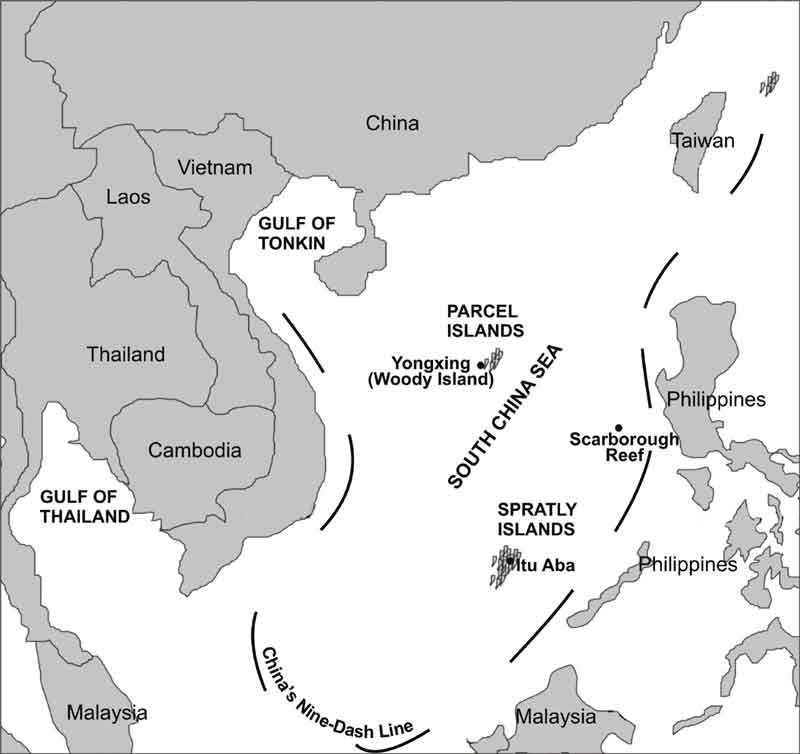
Tensions are mounting in the South China Sea as China flexes its muscles and the Unites States digs their heels in. Taiwan has also voiced its opinion, stating that if China designates an air defense identification zone (ADIZ) over the South China Sea, they will refuse to acknowledge it.
China, on the other hand, has commented on the new stance made by Taiwan – which China considers a breakaway province – with their foreign ministry spokesman, Hong Lei, saying: “many countries have set up ADIZs. This has nothing to do with various countries’ territorial or maritime rights issues.”
China has a track record of imposing ADIZs; establishing one over the East China Sea in 2013. It flies in the face of what is expected from an international court ruling by the Permanent Court of Arbitration in The Hague in coming weeks – a case initiated by the Philippines over South China Sea claims – that will see the courts address Chinese claims contributing to the crisis.

The Laws and the Maritime Boundaries
However, U.S. officials are concerned the court ruling may well be the action that will initiate the ADIZ in the Southern region.
China continues to defy the U.S., Japan and Australia, among other nations, by continuing with the development of ‘artificial islands’ around the disputed $5 trillion per year trade passage.
However, technically, the court cannot interfere with maritime boundaries, reports Manoj Joshi for the Daily Mail, as they are only to be “determined through bilateral negotiations between the parties in question.” Only under a UN Convention on the Laws of the Seas (UNCLOS) can the features of an island be mandated for economic zoning, ranging from 12 nautical miles around a rock to 200 nautical miles for an island.
China has openly refused to participate in the arbitration process, and though any UNCLOS ruling is final and without appeal, China has also stated firmly that they will not abide by its ruling, terming it a ‘kangaroo court.’
As far as the ADIZ is concerned, it has no basis in international law, albeit the U.S., according to Joshi, have established them in the “name of national security,” in the past. However, if China decides to declare an ADIZ, there are possibilities that the airspace will cover the Chinese-Japanese disputed Senkaku Islands, areas overlapping with South Korea and the Chinese concocted “nine-dash line,” which threatens Malaysian territories.
The Nine-Dash Line
The nine-dash line was a new map unveiled in 1953, at the time of the Korean War, covering an area of the South China Sea. It wasn’t until 1968, when “significant hydrocarbon resources” were discovered in the waters, that territorial issues arose. Neighbours from all sides then attempted to occupy and/or claim islands in the South China Sea.
However continual the irritant became, the contentious nine-dash line didn’t rear its ugly head again until 2009 when China submitted it as part of its territory to the UN. In 2012, the country then printed its line on the maps of Chinese citizens’ passports, according to the Financial Times.

In 2014, Daniel Russel, assistant secretary of state for East Asian and Pacific Affairs, pushed the issue for China to “clarify its meaning” when testifying before the House Committee on Foreign Affairs. “Under international law, maritime claims in the South China Sea must be derived from land features,” Russel said at the time. “The international community would welcome China to clarify or adjust its nine-dash line claim to bring it in accordance with the international law of the sea.”
What’s Really at Stake?
The nine-dash line encompasses 1.4 million square miles, asserting Chinese sovereignty.
There are suggested unexplored oil and gas reserves in the South China Sea, though these are supposedly far away from being commercially viable on a large scale.
A $5 trillion trade passage – per year and freedom of navigation. (Note here that China did sign the 1981 treaty – United Nations Convention on the Law of the Sea to uphold this right, yet the U.S. only agreed to it, and never signed it.)
Regional powers vs. the United States and military might? Is it the outgoing of one administration and the incoming of a new one?
Geographically speaking, the South China Sea is as important to the Chinese for security of their ports as the Caribbean is to the United States and the Mississippi ports. For the Chinese, it is vital that they protect their interests.
All in all, when the court announces its decision in the coming weeks, China is, according to them, going to shrug their shoulders to the U.S., who will either put their money where their mouth is…or their foot. Either way, tensions will undoubtedly increase – but to what extent, no one yet knows.
Sources: Mail Online, Reuters, Financial Times, Brookings.edu, USA Today.
This article (High Stakes: South China Sea Dispute Heats Up as Court Readies to Announce Decision) is a free and open source. You have permission to republish this article under a Creative Commons license with attribution to the author AnonWatcher and AnonHQ.com.




